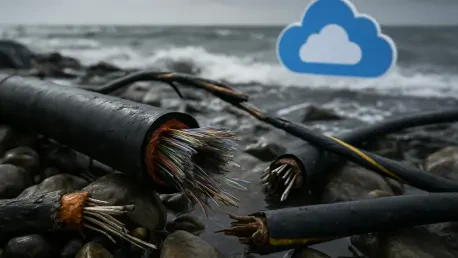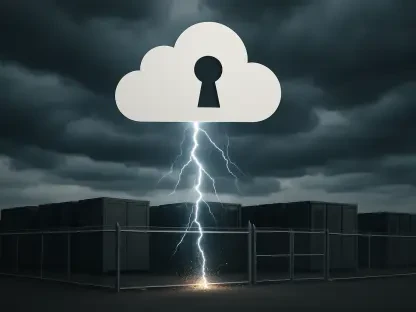In an era where digital connectivity defines daily life, the fragility of the infrastructure supporting it was laid bare on September 6, 2025, when undersea fiber optic cables in the Red Sea were severed, causing significant disruptions. Microsoft reported increased latency on its Azure cloud platform, a critical service for countless businesses worldwide, highlighting the vulnerability of these unseen lifelines that carry 99% of international data traffic. This incident wasn’t merely a technical hiccup; it sent shockwaves through global internet services, impacting everything from financial transactions to personal communications. The Red Sea, a narrow corridor connecting Europe, Asia, and Africa, handles roughly 17% of the world’s internet traffic, making any disruption in this region a matter of urgent concern. As reliance on digital systems grows, with around $1 trillion in daily transactions flowing through these cables, understanding the causes and consequences of such events becomes paramount. This disruption serves as a stark reminder of how interconnected and yet how precarious the digital world truly is, prompting a deeper look into the strategic, geopolitical, and economic dimensions of submarine cable vulnerabilities.
A Critical Hub Under Threat
The Red Sea stands as a pivotal artery in the global telecommunications network, linking three continents through a tight maritime passage. Its significance cannot be overstated, as multiple undersea cable systems converge in this narrow waterway, making it a linchpin for data exchange between Europe, Asia, and Africa. When these cables are damaged, as occurred on September 6, 2025, the impact is immediate and widespread, with services like Microsoft Azure experiencing noticeable delays due to traffic rerouting. This concentration of infrastructure in such a confined space creates a dangerous single point of failure, where even a single cut can disrupt connectivity for millions. The incident underscored how dependent modern society has become on these submerged networks, which are often taken for granted until something goes wrong. Beyond the technical fallout, the Red Sea’s role as a chokepoint amplifies the stakes, as alternative routes are geographically limited and often introduce significant performance penalties.
Geopolitical dynamics further complicate the Red Sea’s strategic importance. Situated near conflict-ridden areas like Yemen, the region is a hotbed of tension where infrastructure can become a target in broader power struggles. The vulnerability of these cables isn’t just a matter of engineering; it’s deeply tied to regional instability that can transform a technical issue into a global crisis. Efforts to diversify cable routes face immense challenges due to the area’s unique geography, leaving little room for redundancy. As digital demand continues to surge, with global internet traffic increasing by 17% in recent years, the pressure on this critical hub only intensifies. The convergence of technology and geopolitics in the Red Sea demands urgent attention from international stakeholders to prevent future disruptions from spiraling into even larger catastrophes.
Geopolitical Flashpoint and Sabotage Risks
The disruptions in the Red Sea are rarely mere accidents; they are often entangled with complex geopolitical conflicts that threaten global stability. The Houthi movement in Yemen, supported by external powers like Iran, has been implicated in attacks on shipping and infrastructure, raising alarms about intentional sabotage of undersea cables. These actions are increasingly viewed as elements of hybrid warfare, where critical systems are targeted to inflict damage without crossing into overt military conflict. The incident on September 6, 2025, which affected Azure services, fits into this troubling pattern, as suspicions of deliberate interference grow amid regional unrest. Such tactics exploit the difficulty of proving intent, often hiding behind plausible deniability while causing significant harm to digital connectivity across continents. The intersection of technology and warfare in this volatile region reveals a new frontier of risk that demands vigilance.
Beyond local actors, global powers like Russia and China are also under scrutiny for their potential involvement in cable disruptions. Russia’s sophisticated deep-sea capabilities and China’s growing control over cable manufacturing through entities like HMN Technologies fuel concerns about state-sponsored interference. Intelligence assessments suggest that these nations may see submarine infrastructure as a strategic tool for disruption or surveillance, leveraging their technological and naval prowess to gain an edge. The Red Sea, already strained by local conflicts, becomes a stage for broader geopolitical rivalries, where digital assets are as critical as physical ones. As hybrid warfare tactics evolve, the international community faces the challenge of protecting these vital networks from threats that blur the line between peace and conflict, necessitating stronger diplomatic and defensive measures.
Economic Ripples Across Industries
The economic consequences of Red Sea cable cuts are profound, reverberating through multiple sectors with startling speed. When connectivity is disrupted, as it was on September 6, 2025, the impact on financial markets is immediate, with delays in transactions worth trillions of dollars daily causing chaos for banks and investors. Past incidents, such as the 2024 disruptions in West Africa, demonstrated how entire regions can be paralyzed, with banking services halted across 16 countries. The modern economy’s reliance on real-time data flow means that even brief interruptions can lead to substantial losses, as businesses scramble to adapt to degraded network performance. The Azure latency issues reported by Microsoft are a case in point, showing how cloud-dependent enterprises suffer when critical infrastructure fails. These events expose the fragility of global commerce in the face of digital vulnerabilities.
Digital industries, particularly those reliant on instantaneous connectivity, bear a heavy burden during such disruptions. Sectors like programmatic advertising and video streaming face significant setbacks as latency undermines real-time bidding and content delivery, directly affecting user experience and revenue. Rerouting traffic through alternative paths, often across terrestrial networks or longer submarine routes, adds further strain, as these backups struggle to handle the sudden load. The cascading effects touch small businesses and large corporations alike, highlighting a shared dependence on undersea cables. As digital transformation accelerates, with internet traffic continuing to climb, the economic stakes of protecting these networks grow higher. Addressing this challenge requires not just technical solutions but also a rethinking of how global trade and technology intersect in an increasingly connected world.
The Daunting Task of Cable Repairs
Repairing damaged submarine cables in the Red Sea presents a formidable challenge, marked by high costs and prolonged timelines. Each incident, such as the one impacting Azure services on September 6, 2025, can take an average of 40 days to resolve, with repair expenses ranging between $1 and $3 million. A limited fleet of just 80 specialized vessels worldwide is often overstretched, particularly when multiple disruptions occur simultaneously. These ships, designed for both installation and emergency fixes, face capacity constraints that delay restoration efforts, leaving businesses and users in limbo. The technical complexity of locating and mending cables on the ocean floor, combined with the sheer scale of global demand, underscores a critical gap in infrastructure resilience. As digital dependency grows, the inadequacy of current repair mechanisms becomes a pressing concern for the telecommunications industry.
Conflict zones like the Red Sea add another layer of difficulty to repair operations. Ongoing hostilities, such as those involving Yemen’s government and Houthi forces, create access restrictions and jurisdictional disputes that hinder swift action. Permitting delays and safety risks in unstable regions often mean that repair crews cannot reach damaged cables promptly, exacerbating downtime for affected services. The 2025 incident highlighted how geopolitical tensions can turn a technical problem into a prolonged crisis, with delays compounding the economic and operational fallout. Without significant investment in additional repair capacity and streamlined international protocols, recovery times are poised to lengthen. The urgency to bolster this aspect of digital infrastructure cannot be ignored, as prolonged outages risk undermining trust in global connectivity systems.
Security Concerns in a Hybrid Warfare Era
Submarine cable disruptions in the Red Sea carry security implications that extend far beyond technical failures, entering the realm of hybrid warfare. Recognized by NATO and allied nations as a strategic threat, these incidents often serve as tools for state and non-state actors to destabilize without engaging in direct military confrontation. The cuts on September 6, 2025, which affected Microsoft Azure, exemplify how infrastructure can be weaponized to disrupt critical services while maintaining plausible deniability. Such tactics exploit the difficulty of attributing responsibility, allowing adversaries to inflict damage under the radar of conventional defense mechanisms. As digital networks become battlegrounds, the need for robust protection strategies grows, with international bodies increasingly prioritizing the safeguarding of these assets against covert attacks.
The private ownership of most undersea cables further complicates security efforts, creating vulnerabilities that hostile entities can exploit. Concerns are mounting over Russia’s deep-sea capabilities and China’s expanding influence in cable networks, which raise the specter of surveillance through tapping or sensor placement. Such actions could compromise sensitive military, economic, and diplomatic communications, posing unprecedented risks to global security. Initiatives like NATO’s 2023 coordination cell and enhanced naval patrols in strategic waters signal a growing commitment to defending these networks. Yet, the potential for intelligence gathering via submarine infrastructure remains a persistent challenge, demanding innovative approaches to secure the digital backbone. The convergence of cybersecurity and geopolitics in this domain underscores the complexity of maintaining a safe and reliable internet in an era of hybrid threats.
Building Resilience for the Future
Looking ahead, the recurring disruptions in the Red Sea underscored by the September 6, 2025, incident demand a concerted push for resilience in global telecommunications infrastructure. Public-private partnerships are essential to enhance repair capabilities, as the current fleet of specialized vessels falls short of meeting rising needs. Diversifying cable routes to reduce dependence on chokepoints like the Red Sea is a critical goal, though geographical constraints limit immediate solutions. Investments in surveillance and maintenance technologies can help detect and prevent damage before it escalates, while international cooperation is vital to streamline repair processes in conflict zones. The growing digital dependency, evidenced by recent surges in internet traffic, makes these steps non-negotiable for ensuring uninterrupted connectivity across borders.
Beyond technical fixes, addressing the geopolitical drivers of cable disruptions is equally important. Diplomatic efforts to mitigate conflicts in volatile regions like the Red Sea could reduce the risk of deliberate sabotage, while coordinated responses among nations can deter state-sponsored interference. The economic and security stakes of these networks necessitate a global framework for protecting undersea infrastructure, balancing private ownership with public interest. As hybrid warfare tactics evolve, proactive measures—ranging from naval patrols to advanced monitoring systems—must keep pace to safeguard against emerging threats. The path forward lies in building a more robust and redundant digital ecosystem, one that can withstand both natural and human-induced challenges, ensuring that the backbone of global communication remains unbroken in the face of adversity.









